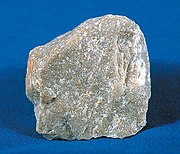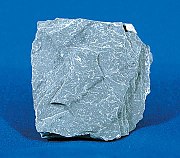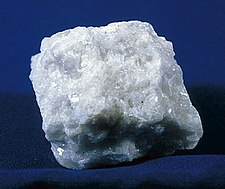FELSITE:

Felsite is a very fine grained volcanic rock that may or may not contain larger crystals. Felsite is a field term for a light colored rock that typically requires petrographic examination or chemical analysis for more precise definition. Color is generally white through light grey, reds to tan and may include any color except dark grey, green or black (the colors of traprock).[1] The mass of the rock consists of a fine-grained matrix of felsic materials, particularly quartz, sodium and potassium feldspar, and may be termed a quartz felsite or quartz porphyry if the quartz phenocrysts are present. This rock is typically of volcanic origin, and may be found in association with obsidian and rhyolite. In some cases, it is sufficiently fine-grained for use in making stone tools.
OBSIDIAN:

Obsidian is a naturally occurring glass formed as an extrusive igneous rock. It is produced when felsic lava extruded from a volcano cools rapidly through the glass transition temperature and freezes without sufficient time for crystal growth. Obsidian is commonly found within the margins of rhyolitic lava flows known as obsidian flows, where cooling of the lava is rapid. Because of the lack of crystal structure, obsidian blade edges can reach almost molecular thinness, leading to its ancient use as projectile points, and its modern use as surgical scalpel blades.[1] Technically, not a rock.
QUARTZITE

Quartzite (from German Quarzit[1]), not to be confused with the mineral quartz, is a hard, metamorphic rock which was originally sandstone.[2] Sandstone is converted into quartzite through heating and pressure usually related to tectonic compression within orogenic belts. Pure quartzite is usually white to grey. Quartzites often occur in various shades of pink and red due to varying amounts of iron oxide. Other colors are commonly due to impurities of minor amounts of other minerals.
SLATE

Slate is a fine-grained, foliated, homogeneous, metamorphic rock derived from an original shale-type sedimentary rock composed of clay or volcanic ash through low grade regional metamorphism. The result is a foliated rock in which the foliation may not correspond to the original sedimentary layering. Slate is frequently grey in colour especially when seen en masse covering roofs. However, slate occurs in a variety of colours even from a single locality. For example slate from North Wales can be found in many shades of grey from pale to dark and may also be purple, green or cyan.
PHYLLITE

Phyllite is a type of foliated metamorphic rock primarily composed of quartz, sericite mica, and chlorite; the rock represents a gradiation in the degree of metamorphism between slate and mica schist. Minute crystals of graphite, sericite, or chlorite impart a silky, sometimes golden sheen to the surfaces of cleavage (or schistosity).
The protolith (or parent rock) for a phyllite is a slate. Its constituent platy minerals are larger than those in slate but are not visible with the naked eye. Phyllites are said to have a "phyllitic texture" and are usually classified as having a low grade on the regional metamorphic Barrovian sequence.
SCHIST

The schists form a group of medium-grade metamorphic rocks, chiefly notable for the preponderance of lamellar minerals such as micas, chlorite, talc, hornblende, graphite, and others. Quartz often occurs in drawn-out grains to such an extent that a particular form called quartz schist is produced. By definition, schist contains more than 50% platy and elongated minerals, often finely interleaved with quartz and feldspar. Schist is often garnetiferous.
The individual mineral grains in schist, drawn out into flaky scales by heat and pressure, can be seen by the naked eye. Schist is characteristically foliated, meaning the individual mineral grains split off easily into flakes or slabs. The word schist is derived from the Greek word σχίζειν meaning "to split", which is a reference to the ease with which schists can be split along the plane in which the platy minerals lie.
GNEISS

Gneiss (pronounced /ˈnaɪs/) is a common and widely distributed type of rock formed by high-grade regional metamorphic processes from preexisting formations that were originally either igneous or sedimentary rocks, which most commonly forms on ancient seabeds. Gneissic rocks are usually medium to coarse foliated and largely recrystallized but do not carry large quantities of micas, chlorite or other platy minerals. Gneisses that are metamorphosed igneous rocks or their equivalent are termed granite gneisses, diorite gneisses, etc. However, depending on their composition, they may also be called garnet gneiss, biotite gneiss, albite gneiss, etc. Orthogneiss designates a gneiss derived from an igneous rock, and paragneiss is one from a sedimentary rock. Gneissose is used to describe rocks with properties similar to gneiss.
MARBLE

Marble is a nonfoliated metamorphic rock resulting from the metamorphism of limestone, composed mostly of calcite (a crystalline form of calcium carbonate, CaCO3). It is extensively used for sculpture, as a building material, and in many other applications. The word "marble" is colloquially used to refer to many other stones that are capable of taking a high polish.
That's all the Stone Layers. Next one is metal ores.

 Author
Topic: Learning about all our Dwarf Fortress Rocks! (Read 53357 times)
Author
Topic: Learning about all our Dwarf Fortress Rocks! (Read 53357 times)

